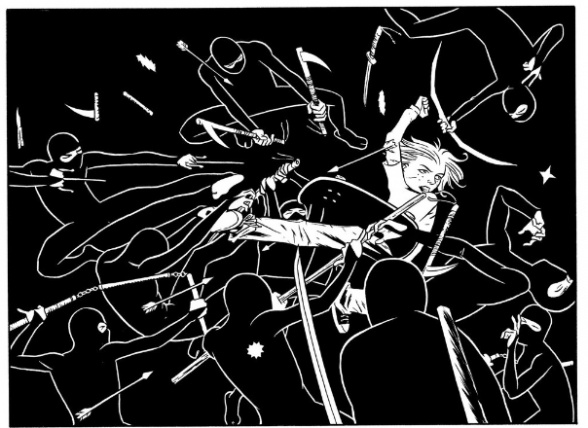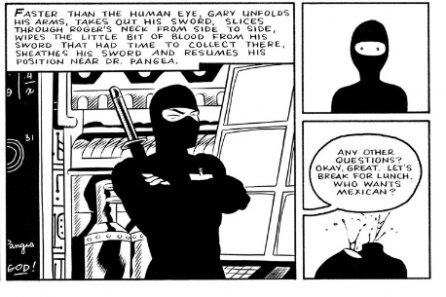
“Street Angel” is pure, unadulterated punk.
Originally published in 2004, Jim Rugg and Brian Maruca’s series is a loving send-up of kung-fu movies, Silver Age comics, street crime dramas, and coming-of-age stories. And now, for its tenth anniversary, AdHouse Books has released all of Jesse Sanchez’s old adventures in this fantastic hardcover collection, including the original five issues as well as various one-page strips, short stories, and pinups. True to form, they’ve even maintained the same pink color Rugg originally slapped these books with, and it continues to pop out from its place on my bookshelf.
“Street Angel” consists of a series of stand alone stories starring skateboarding street defender, Jesse Sanchez. There’s not much of an overarching storyline, other than Jesse’s mission to fight “poverty, drug abuse, nepotism, and ninjas.” In fact, only one other character makes multiple appearances throughout the series: the bilateral amputee, The Bald Eagle, who’s like the modern, inner-city version of Half-Soldier from The Good, the Bad, and the Ugly.
I actually think that having an overarching story, a “wait till next time to see what Jesse will do next” sort of plot would distract from the spirit and energy of the comic — from the crazy world Rugg and Maruca have built. Not only that, but the types of villains Jesse confronts are so eccentric and delightfully bizarre that having them hang around for full-out character arcs would render their idiosyncratic motivations and characterizations annoying.

The result, then, is this highly entertaining, angry, anarchic, sometimes heartbreaking, and frequently bonkers work, where it feels like Rugg and Maruca threw whatever ridiculous idea that occurred to them on the drawing board. It makes little sense, but that does not stop it from being captivating.
The first few issues of “Street Angel” are definitely the strongest. It’s here you see Rugg with the most passion and energy for the project. The series kicks off with Jesse being summoned by the Mayor of the City: his daughter has been kidnapped and is being held hostage by the wannabe evil mastermind, Dr. Pangea. Pangea wants to reunite the Earth’s continents back into one massive landscape, because then he will be granted massive power or something. That’s actually not all that important. He literally exists as a catalyst for Jesse to fight ninjas and muscled assassins, and for Rugg to deliver some crazy clever and well staged action sequences.
Later on, she’s called in again and again to battle time-traveling conquistadors, weresharks, possessed demon girls who hang around in hospital ventilation ducts, and deranged white trash assassins. Oh, and we can’t forget the ninjas. Always with the ninjas.
Rugg is a restless artist. Trained as a graphic designer, his eye constantly attempts the most visually striking way to present his set-pieces. And one of the fun things about experiencing this series is seeing Rugg not exactly sure what he’s doing, but nevertheless willing to experiment with any idea that strikes him. Everything about this book, from the tone to the characters to the ridiculous plots, grants him a chance to try something new and different. Heavily packed, dense shots of Jesse jumping into battle? Pages with so many panels the figures are symbolic figures? Gorgeous spreads with thick brushy inks like Charles Burns? Jittery line work that looks like Frank Miller when he was still trying to draw? Those are all in here.

Rugg takes all kinds of risks and chances that someone’s who’s been working professionally for years might avoid. Of course, it helps that he didn’t have some kind if corporate entity looking over his shoulder and trying to make sure he maintained a sense of mass appeal. Some of these risks land. Some don’t. But the relentless energy behind the book moves fast enough that a new gag has already come around.
The plots all exist to give him a chance to play around, and so rarely stray from parodies. The tongue-in-cheek tone excuses the script’s less than stellar dialogue and structure, where even the most eye-rollingly goofy moments can be easily waved away as a joke.
The problem with that, though, is when moments of true emotion and empathy occur, they tend to feel jarring. Out of place. More than a little awkward. This is because a.) they’re tonally different than everything else that came before, b.) none of those events and plot or character points set us up for this sudden empathy blast, and c.) they make us, as readers, realize the potential of the story, and they make us want/expect more of that sensibility.
Continued belowAs I was reading this book, I was reminded a lot of Taiyo Matsumoto’s “Tekkonkinkreet.” Both stories feature orphans living in some beat up streets though still determined to protect their city and home. Both stories feature off-kilter artwork that makes the narrative come off as more disorienting and bizarre. Both of them feature kids who want a home. I bring this up, because “Tekkonkinkreet” established fairly early on that it was going to strike a balance between the fun violent stuff and the brotherly love stuff. When Rugg and Maruca bring in Jesse’s sadness and loneliness, it’s not until well after the style and voice of the series had been established.
It comes up in Issue 4, where Jesse joins this other homeless man for a meal and avoids this girl she knows from school. I think Rugg and Maruca wanted to pull back from the wild and fantasized lifestyle of skateboarding and crimefighting they had given Street Angel, and I actually feel that they were successful. At that moment, I felt for Jesse Sanchez, I could see her as a person who knows she’s never going to get out of this life, that she’s eating lunch with essentially a future version of herself. (By the way, a future version of herself does show up, and it’s just as hysterical as you could hope.)

But I have trouble justifying it because nothing else in the book even hinted at the possibility of discussing this.
And it’s not like Rugg and Maruca are interested in exploring this element, because they immediately go off on different tangents starring Jesse Sanchez. Yet, you can feel the potential of what Rugg and Maruca hit here hovering over the rest of the stories and strips and cartoons, and I think they have a difficult time regaining their more manic footholds.
Ultimately, this lets the book sort of — fizzle out. By the last couple stories, I got the sense that Rugg and Maruca had burned themselves out and were struggling to maintain that same energy and passion they exploded in with. The jokes don’t land as strongly and they toe the line between being mocking and offensive, while never quite successfully striking either right.
Yet, as I’ve been saying, the charm and strength of throughout this entire comic comes from Rugg’s artwork. Admittedly, it’s only been recently that Rugg has come to my attention, following a recent stint on the “Adventure Time” comic with Ryan North, and I think you can see strong evidence of why he was chosen to draw that other book.
And the work AdHouse has done in reprinting it! The lines are crisp and clean. The pages feel sturdy, and the binding doesn’t act like it’s going to unwind and unravel the moment you try to read it. It’s obvious he cares about the way his books look, and AdHouse has done well in maintaining that unique and enticing presentation in their reprint. It’s the kind of collection a cool, cult, wickedly experimental and wild book deserves.

At its best, “Street Angel” is a rampantly entertaining, engrossing, and engaging read. It’s crazy hysterical and imaginative and leaves you with an adrenaline-fueled thrill. At its weaker moments, Rugg still gives you a lot to admire and respect. In fact, at its weaker moments, it’s never necessarily bad, but instead makes you realize it had potential to be more than a parody of these kung-fu/coming-of-age narratives. It’s worth seeking out and admiring.
What was once apparently a very difficult comic to get ahold of, now is available to you in many forms! Boing Boing is serializing it on their Web site; Comixology has it hosted through MonkeyBrain comics; and of course, there’s this gorgeous hardcover edition from AdHouse Books.



